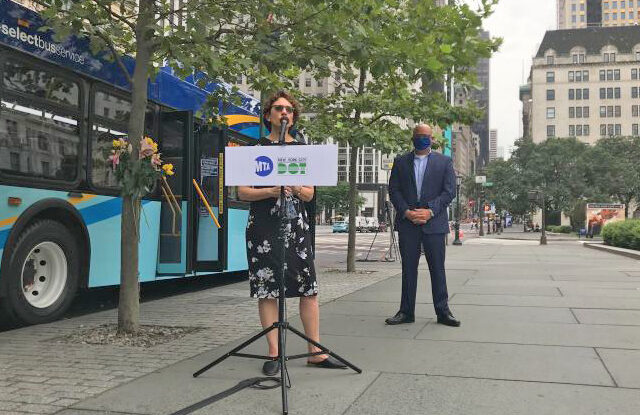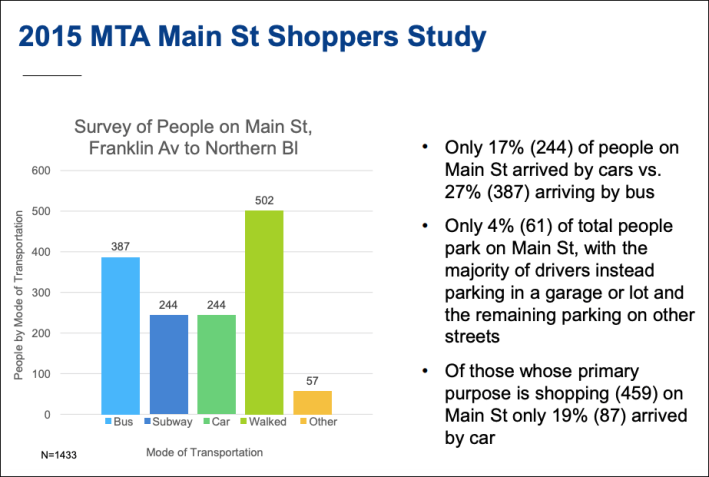ANATOMY OF A BUSWAY FAILURE: ‘Business Lives Matter’ Protesters Had Some ‘Good Ideas,’ DOT Commish Says
9:57 PM EDT on August 6, 2020

DOT Commissioner Polly Trottenberg during a press conference over the summer. Photo: Dave Colon
They threw their own busway under the bus.
Department of Transportation Commissioner Polly Trottenberg admitted on Thursday that she capitulated to a small group of opponents of the city's plan for a short car-free bus-only stretch of Flushing's Main Street because the anti-transit group actually had some “good ideas” that — once again — sent her agency scurrying back to its drawing board in unwarranted shame.
That admission comes just days after the opponents — led by Council Member Peter Koo, who appropriated the "Black Lives Matter" movement to champion supposedly endangered business owners over transit users — showed up at a DOT press conference last week to protest a busway that the de Blasio administration said would help more than 150,000 riders daily.
“We had several hundred pretty passionate protesters show up and they were clearly a lot of local businesses from the area. I think we have very good arguments to make about what an important project it is, but we're also going to listen to those voices,” said Trottenberg, who added that Koo’s comments were “offensive.”
But not offensive enough to stop the city from appeasing him — and other upholders of car culture — by suspending the busway indefinitely. When the mayor announced it in early June, he promised it would be done by the end of the month. We are now well into August.
All of NYC’s plans for bike lanes, and the huge implementation delay amid the 2020 bike boom pic.twitter.com/1OVfUqWul2
— Jon Orcutt (@jonorcutt) August 6, 2020
“There were a lot of different people in that crowd and some of them said things which we found offensive. But a lot of them were genuine small business owners and they had some good ideas for us actually, around neighboring streets and tweaks we could make for loading, and looking at placards,” said Trottenberg. “When people weren't yelling and screaming, I talked to a few folks out there who I thought had some ideas we would want to take a look at.”
DOT did not elaborate on the ideas.
Trottenberg’s admission comes days after the DOT abruptly cancelled its Aug. 3 busway town hall following Koo’s comments. (Trottenberg threw Streetsblog under the bus for not attending that July 30 presser — where, presumably, our questions would have allowed her to demonstrate the positives of the busway — but her agency never actually sent Streetsblog a press advisory about the event, as Streetsblog's Dave Colon reported.)
Polly Trottenberg tried to throw me under the bus this morning, and then I threw the DOT press team under the bus in response and everyone watching the MTA livestream watched it happen https://t.co/3UZgglm0Zl
— Good Idea Dave (@DaveCoIon) August 6, 2020
DOT has not rescheduled the town hall, nor has the agency said when the city will remove cars from those .3 miles of Main Street, between Northern Boulevard and Sanford Avenue, just like it did along the successful 14th Street busway implemented last year.
“I don't have a hard date [for when it's going in]. We're going to reschedule that town hall very soon and let everybody know. It'll be sooner as opposed to later, but I can't give you a date today,” Trottenberg said.
None of the other four busways that Mayor de Blasio announced back in June are anywhere close to where the Flushing busway was said to have progressed. And all the projects are vital.
If @NYCMayor doesn't want the Flushing community to buy cars, perhaps he can build the #busway he promised in June to #FixMainSt and improve public transit in Northeast Queens https://t.co/N5pc9gP1ct
— John Choe (@jxcnyc) August 6, 2020
In May 2019, the Q44 SBS inched north on Main Street at no more than just 3.6 miles per hour on weekday mornings, and 2.1 miles-per-hour on Saturdays, according to DOT.
And between February 2019 and February 2020 — one month before the city shutdown due to the Covid-19 pandemic — the average speed on the entire length of the Q44 SBS's route never topped 9.1 miles-per-hour. But by May — the height of the city’s lockdown — bus speeds shot up to 11.7 miles-per-hour, and then quickly fell back down to pre-pandemic speeds by June — offering a glimpse of what less cars on the road means for beleaguered bus riders.
And the busway wouldn't just help riders — it would actually help businesses too, according to data from DOT. According to a 2015 study of shoppers on Main Street, only 17 percent of people arrived by cars, while 27 percent arrived by bus. And even fewer people, just 4 percent, actually parked on the usually congested corridor in front of a storefront.

But that hasn't stopped opponents from claiming that making just about a quarter-mile of Main Street car-free would actually hurt businesses' bottom lines. A group called the Downtown Flushing Transit Hub BID claimed it conducted a survey of Main Street businesses — and the opposition was “unanimous,” the group told the Queens Eagle.
But one Flushing business-booster, who supports the busway, blasted DOT earlier this week for giving into the opponents.
“One of the goals was to make it easier for essential workers to get to work and help businesses reopen and just delaying it makes the situation worse,” John Choe, executive director of the Greater Flushing Chamber of Commerce, told Streetsblog.
Like Main Street now, some residents and businesses along 14th Street pushed back against the city’s plan for a busway there. But now, months in, opponents have remained silent and it is considered a complete success, with bus ridership increasing thanks to the dramatically reduced travel times for long-suffering transit users.
It's not surprising that the city would stall its own plan with an eye towards appeasing opponents — in fact, that's common practice. Earlier this year, the city similarly put an indefinite suspension on its own long-delayed Queens Boulevard bike lane when — just hours after Trottenberg announced that the bike lane would finally be completed this summer — Mayor de Blasio reneged and asked the agency to reconsider its plan.
Like Trottenberg now, the mayor claimed an intransigent local pol had suggested an alternate approach — though, in fact, no alternative existed.
There's nothing wrong with listening to those voices, but the issue becomes when DOT then centers them and lets them guide and change the city's plan for a busway that would help thousands of people everyday, wrote activist Doug Gordon in Streetsblog last week.
"The commissioner often notes that some business owners have strong opinions about bus lanes, but you know who else does, only in a very different way? Bus riders. And there are a lot more of them who would benefit," Gordon wrote in an opinion piece demanding more courage from the commissioner. "Trottenberg is not entirely wrong. Opposition to her department’s work can command outsized attention and, if not addressed or anticipated, derail even the most sensible transportation plan. But rather than leading with and amplifying such complaints, she should use language that keeps a project’s beneficiaries front and center."
As she did on Thursday, Trottenberg defended her approach last week at a CityLaw breakfast, where she said she feels inclined to listen to business owners even though she knows that street safety improvements actually help them.
“I would say this there's certainly evidence that, in places where we build bus lanes and bike lanes, at the very least, the economics of businesses is not harmed, and in some cases enhanced," she said. "But people need to be a little realistic. The opposition to these projects can be very, very passionate and it’s not to say that we don't go ahead with these projects, but I think we also want to work with the local businesses.”
Additional reporting by Dave Colon
Julianne Cuba joined Streetsblog in February, 2019, after three years covering local news and politics at The Brooklyn Paper. There, she also covered the notoriously reckless private carting industry and hit-and-runs. A 2015 graduate of Stony Brook University’s School of Journalism Master’s Program, she lives in Brooklyn. Julianne is on Twitter at @julcuba. Email Julianne at julianne@streetsblog.org
Stay in touch
Sign up for our free newsletter
More from Streetsblog New York City
Friday’s Headlines: Canal Street Follies Edition
Manhattan Borough President Mark Levine isn't happy. Plus other news.
Daylight Again: Bronx Community Board Backs Parking Ban at Intersections
The Boogie Down is down with daylighting!
Community Board Wants Protected Bike Lane on Empire Blvd.
Brooklyn Community Board 9 wants city to upgrade Empire Boulevard's frequently blocked bike lane, which serves as a gateway to Prospect Park.
The Brake: Why We Can’t End Violence on Transit With More Police
Are more cops the answer to violence against transit workers, or is it only driving societal tensions that make attacks more frequent?
Report: Road Violence Hits Record in First Quarter of 2024
Sixty people died in the first three months of the year, 50 percent more than the first quarter of 2018, which was the safest opening three months of any Vision Zero year.




